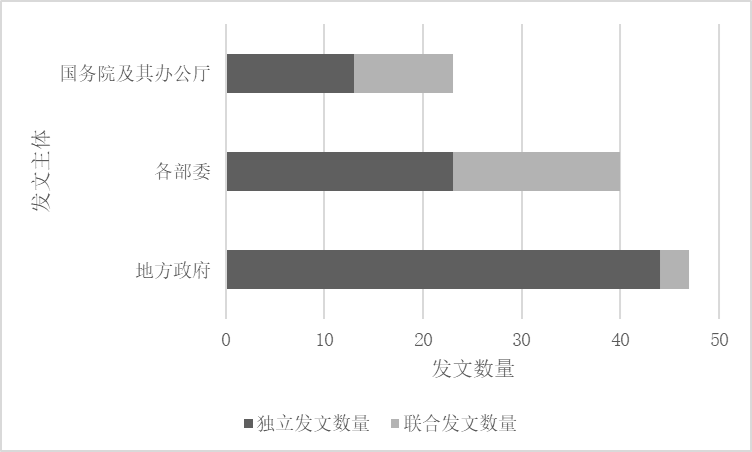 PDF(1869 KB)
PDF(1869 KB)


Quantitative Evaluation of Digital Inclusion Policy Text Based on PMC Index Model
Tang Aixin, Zhu Siya, Li Yuhai
Knowledge Management Forum ›› 2024, Vol. 9 ›› Issue (1) : 79-92.
 PDF(1869 KB)
PDF(1869 KB)
 PDF(1869 KB)
PDF(1869 KB)
Quantitative Evaluation of Digital Inclusion Policy Text Based on PMC Index Model
[Purpose/Significance] This study aims to explore the current status of digital inclusion policies,evaluates the digital inclusion policy quantitaively,and provides support and reference for the formulations and improvement of digital inclusion policy for vulnerable groups, and assist information vulnerable groups in integrating into digital life and enjoy digital dividends. [Method/Process] Based on scientific coding methods, the article constructed a three-dimensional quantitative evaluation framework of "policy structure-policy tools-policy effectiveness", excavated 109 digital inclusion related policies issued by central and local governments, and sorted out the shortcomings of existing policies in order to achieve optimization of digital inclusion policies. [Result/Conclusion] Research has found that there are certain deficiencies in the breadth of participation of policy subjects and the allocation of policy tools, which limit the realization of policy effectiveness. It is necessary for government departments to mobilize the enthusiasm of participating subjects and allocate policy tools reasonably in order to promote the systematic development of digital inclusion policies for vulnerable groups, thereby assisting information vulnerable groups in better mastering digital technology.

digital inclusion / digital divide / PMC index model / policy text
| [1] |
新华社.习近平继续出席二十国集团领导人第十七次峰会[EB/OL].[2023-10-16]. http://www.gov.cn/xinwen/2022-11/16/content_5727241.htm.(XINHUA NEWS AGENCY. President Xi continues to attend the 17th G20 Leaders' Summit [EB/OL].[2023-10-16]. http://www.gov.cn/xinwen/2022-11/16/content_5727241.htm.)
|
| [2] |
闫慧,张鑫灿,殷宪斌.数字包容研究进展:内涵、影响因素与公共政策[J].图书与情报,2018(3):80-89.(YAN H,ZHANG X H,YIN X B. Research advances in digital inclusion: definitions , influencing factors a public policy[J]. Library & information,2018(3):80-89)
|
| [3] |
SMITH C. An analysis of digital inclusion projects: three crucial factors and four key components[J]. Journal of information technology education: research, 2015, 14(1):179-188.
|
| [4] |
KEATIN C, AUDENHOV L V, CRAFFERT L. Social support for digital inclusion of women in South African townships[J]. Telematics informatics, 2022,75: 101893.
|
| [5] |
JAMIL S. From digital divide to digital inclusion: challenges for wide-ranging digitalization in Pakistan[J]Telecommunications policy, 2021,45(8):102206.
|
| [6] |
曾刚,邓胜利.我国数字包容政策分析与对策研究——基于政策工具视角[J].信息资源管理学报,2021,11(5):73-83. (ZENG G, DENG S L. China’s digital inclusion policy analysis and countermeasure research based on the perspective of policy tools[J]. Journal of information resources management,2021,11(5):73-83.)
|
| [7] |
金燕,杨会娟,毕崇武,等.面向老年人的我国数字包容政策量化分析研究[J].现代情报,2023,43(3):53-63.(JIN Y,YANG H J ,BI C W ,et al. Quantitative analysis of China's digital inclusion policies for the elderly[J]. Journal of modern information,2023,43(3):53-63.)
|
| [8] |
卜淼.公共图书馆促进数字包容的国际进展与我国对策[J].图书馆理论与实践,2023(2):34-41. (BU M. International progress and China's countermeasures in public library promoting digital containment[J]. Library theory and practice,2023(2):34-41.)
|
| [9] |
李江,刘源浩,黄萃,等.用文献计量研究重塑政策文本数据分析——政策文献计量的起源、迁移与方法创新[J].公共管理学报,2015,12(2):138-144,159. (LI J, LIU Y H, HUANG C, et al. Remolding the policy text data through documents quantitative research: the formation, transformation and method innovation of policy documents quantitative research[J]. Journal of public management,2015,12(2):138-144,159.)
|
| [10] |
晏子,章晓懿.政策价值理念与政策工具错配了吗?——基于1978-2018年中国残障人士就业政策文本的实证分析[J].人口与发展,2020,26(4):86-100.(YAN Z,ZHANG X Y. Is the policy value concept mismatched with the policy tool?——an empirical analysis based on the employment policy of disabled people in China during 1978-2018[J] Population and development,2020,26(4):86-100.)
|
| [11] |
郭俊华,王阳.乡村振兴背景下农村产业政策优化调整研究[J].经济问题,2022(1):85-92. (GUO J H, WANG Y. Research on the optimization and adjustment of rural industrial policy under the background of rural revitalization[J]. On economic problems,2022(1):85-92.)
|
| [12] |
赵筱媛,苏竣.基于政策工具的公共科技政策分析框架研究[J].科学学研究,2007(1):52-56. (ZHAO X Y, SU J. An analysis framework for public S&T policies:the perspective of policy tools[J]. Studies in science of science,2007(1):52-56.)
|
| [13] |
ROTHWELL R, ZEVELD W. Reindustrialization and technology [M].London: Longman Group Limited,1985.
|
| [14] |
许昕然,龚蛟腾.政策工具视角下的乡村文化振兴政策文本量化研究[J].图书馆论坛,2023,43(4):69-78.(XU X R,GONG J T. A quantitative study of texts on rural cultural revitalization policy from the perspective of policy tools[J]. Library tribune,2023,43(4):69-78.)
|
| [15] |
胡扬名,刘鲜梅,宫仁贵.中国智慧养老产业政策量化研究——基于三维分析框架视角[J].北京航空航天大学学报(社会科学版),2023,36(2):67-77. (HU Y M, LIU X M, GONG R G. Quantitative study of China's policies on smart elderly care industry: based on a Three-Dimensional analytical framework[J]. Journal of Beijing University of Aeronautics and Astronautics(Social sciences edition),2023,36(2):67-77.)
|
| [16] |
刘国佳,韩玮,陈安.基于三维分析框架的突发公共卫生事件应对政策量化研究——以新冠肺炎疫情为例[J].现代情报,2021,41(7):13-26,48.(LIU G J,HAN W,CHEN A. Quantitative study of public health emergency response policies based on a Three-Dimensional analysis framework——taking the COVID-19 as an example[J]. Journal of modern information,2021, 41(7):13-26,48.)
|
| [17] |
ESTRADA M R, YAP S F , NAGARAJ S. Beyond the ceteris paribus assumption: modeling demand and supply assuming omnia mobilis[J]. Social science electronic publishing, 2010(2):185-194.
|
| [18] |
ESTRADA, M A R. Policy modeling: definition, classification and evaluation[J]. Journal of policy modeling, 2011,33(4):523-536.
|
| [19] |
谢尊贤,凌路通.基于PMC指数模型的互助养老背景下农村幸福院管理政策量化研究[J].经济研究导刊,2022(36):68-70.(XIE Z X,LING L T. Quantitative research on management policies of rural happiness homes under the background of mutual aid and elderly care based on PMC model[J]. Economic research guide,2022(36):68-70.)
|
| [20] |
翟运开,郭柳妍,赵栋祥,等.基于PMC指数模型的远程医疗政策评价[J].信息资源管理学报,2022,12(2):112-122,137. (ZHAI Y K, GUO L Y, ZHAO D X, et al. Evaluation of telemedicine policies based on PMC index model[J]. Journal of information resources management,2022,12(2):112-122,137.)
|
| [21] |
张永安,郄海拓.金融政策组合对企业技术创新影响的量化评价——基于PMC指数模型[J].科技进步与对策,2017,34(2):113-121.(ZHANG Y A,QIE H T. Quantitative evaluation of the impact of financial policy combination to enterprise technology innovation——based on the PMC-Index model[J]. Science & technology progress and policy,2017, 34(2):113-121.)
|
| [22] |
宋大成,焦凤枝,范升.我国科学数据开放共享政策量化评价——基于PMC指数模型的分析[J].情报杂志,2021,40(8):119-126.(SONG D C.JIAO F Z,FAN S. Quantitative evaluation of China's open and sharing policies of scientific data: based on PMC Index model[J]. Journal of intelligence,2021,40(8):119-126.)
|
汤艾馨:提出研究思路,撰写与修改论文;
朱斯雅:收集、分析文献资料,修改论文;
李玉海:修改论文及论文审核定稿。
/
| 〈 |
|
〉 |